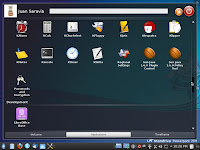
The installation process is basically the same that one finds in previous Powerpack versions. However, this time, the DVD waits a bit before it boots. That gives newbies some time to read the instructions on the screen, which is good.
The installation process also has a main difference: this PowerPack version offers you more customization of the computer instead of simply bloating it up with all kinds of software.
 So, you get to choose whether or not to install games, multimedia programs, documentation, or if you want to install your own packages. It also gives you desktop options: KDE, Gnome 2.32, or LXDE. Why not Gnome 3? Well, I suppose that since KDE comes with the ROSA SimplyWelcome as default, they chose to avoid some duplicity.
So, you get to choose whether or not to install games, multimedia programs, documentation, or if you want to install your own packages. It also gives you desktop options: KDE, Gnome 2.32, or LXDE. Why not Gnome 3? Well, I suppose that since KDE comes with the ROSA SimplyWelcome as default, they chose to avoid some duplicity.For the summary, if you define a country, you can also choose to install IMEs to type Chinese, Korean, Japanese, etc. I chose iBUS.
 After the selection, the installer downloaded the necessary packages. This is convenient, but it is also offered in the free Mandriva Desktop 2011 version. You create your account and choose your avatar (I chose the cat) and then you are ready to let the system reboot. I liked the fact that the old booting screen is back...Well, sort of: they combined the Mandriva 2010 and 2011 booting screens! After a while, you are finally taken to your Mandriva 2011 PowerPack desktop:
After the selection, the installer downloaded the necessary packages. This is convenient, but it is also offered in the free Mandriva Desktop 2011 version. You create your account and choose your avatar (I chose the cat) and then you are ready to let the system reboot. I liked the fact that the old booting screen is back...Well, sort of: they combined the Mandriva 2010 and 2011 booting screens! After a while, you are finally taken to your Mandriva 2011 PowerPack desktop:

I really liked the wallpaper because of its colors and because it brings memories of previous PowerPack versions.I fired up the SimpleWelcome and noticed two things: At the top of the screen, my cat avatar was replaced by an image of some pebbles, the avatar of the Guest account. No matter if I changed the image using KDE controls or Mandriva Control Center, the pebbles didn't go away. However, if I logged out, I coud see the image of the cat.
The other thing I noticed is that there were lots of programs that were not offered in the free version, although you can get them from the repositories anyway. The main problem that a newbie could face is probably getting to configure drivers correctly, which is one of the additional values that PowerPack offers.
Here are the images of the application categories:







Firefox version is 8.0.
Then, it ocurred to me to delete the Guest account and... voila!, my cat avatar finally appeared at the top.

I think that the PowerPack version is a good option for newbies who are not interested in spending some time learning how to configure video (yes, Flash is working out of the box) and that want games, more software, or additional value (support) out of the box for a fraction of the price they would have paid for Windows. I got the discount, so Mandriva 2011 PowerPack cost me $47.20 instead of $59. Was it worth it? Well, for me, it was a satisfactory purchase.
So was the access to the PCLinuxOS PASS.
To be honest, I cannot regret having used little amounts of money to support Linux projects. After all, Windows cost me a lot more and, if I add up all the money I wasted paying technicians to destroy my data and put Windows back, I can say that I have a good reason not to complain.
My only regret is not being able to make a small contribution to Mageia.
Maybe some day...


















